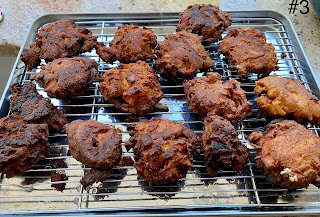Ingredients (X 1, made 12 muffins)
For the crumbs:
1/2 cup packed light brown sugar
3/4 teaspoon pumpkin pie spice
1/2 cup flour
1 1/2 tsp cinnamon
4 tbs butter
1 tsp. salt (optional)
For the muffins:
Juice 3 apples. Drain the pulp (1,2,&3) and save both the pulp and the juice.
1 to 1 1/2 cup of apple pulp.
1 3/4 cups all-purpose flour,
1 teaspoons ground cinnamon,
2/3 cup unsalted butter, softened,
3/4 cup granulated sugar
2 large eggs, at room temperature
1/2 teaspoon kosher salt; for table salt use half as much by volume
1/2 teaspoon baking powder
1/2 teaspoon baking soda
1/2 cup sour cream, at room temperature
1/3 cup apple juice, at room temperature.
Directions:
Prepare oven and cooking utensils: Adjust oven rack to middle position and preheat oven to 400°F. Line a 12-cup muffin tin with paper liners.
Make the crumbs for the Muffins: Stir together brown sugar, pie spice,1/2 cup of the flour, and 1 1/2 teaspoons of the cinnamon in a medium bowl until well combined. Work in 4 tablespoons of the butter using fingertips until mixture is well combined and resembles wet sand. Set aside. (On a whim my wife decided to add 1 tsp. of salt. This was a remarkable improvement. The salt complemented and accentuated the sweetness of the crumbs. It also provided a surprising note of enrichment.)
Make the batter for the muffin: In a large bowl with an electric mixer, beat granulated sugar and remaining 2/3 cup butter on medium speed until fluffy, 3 to 4 minutes, stopping to scrape down sides as needed. Add eggs, one at a time, beating until combined after each addition, about 30 seconds.
In a medium bowl, whisk together salt, baking powder, baking soda, flour, and remaining 1 teaspoon cinnamon. Whisk together sour cream and apple juice until well combined. Stir flour mixture into butter mixture in 3 additions, alternating with sour cream mixture, until flour mixture is moistened but large flour streaks remain.
Assembly: Spoon batter into bottom of each paper liner. Sprinkle 1 packed teaspoon brown sugar mixture evenly over batter in each muffin liner
Bake for 5 minutes. Reduce oven temperature to 375°F and continue baking until a wooden pick inserted in center comes out clean, 12 to 18 minutes, rotating pan halfway. Let cool in pan 10 minutes. (#4)\
These were very good muffins and a bit less work than the previous version of apple pie muffin. It had a very tender moist texture with a subtle apple flavor. The salted crumb topping was a nice surprise accentuating the taste of the crumbs that complemented the slightly sweet apple flavor of the muffins.
For the muffins:
Juice 3 apples. Drain the pulp (1,2,&3) and save both the pulp and the juice.
1 to 1 1/2 cup of apple pulp.
1 3/4 cups all-purpose flour,
1 teaspoons ground cinnamon,
2/3 cup unsalted butter, softened,
3/4 cup granulated sugar
2 large eggs, at room temperature
1/2 teaspoon kosher salt; for table salt use half as much by volume
1/2 teaspoon baking powder
1/2 teaspoon baking soda
1/2 cup sour cream, at room temperature
1/3 cup apple juice, at room temperature.
Directions:
Prepare oven and cooking utensils: Adjust oven rack to middle position and preheat oven to 400°F. Line a 12-cup muffin tin with paper liners.
Make the crumbs for the Muffins: Stir together brown sugar, pie spice,1/2 cup of the flour, and 1 1/2 teaspoons of the cinnamon in a medium bowl until well combined. Work in 4 tablespoons of the butter using fingertips until mixture is well combined and resembles wet sand. Set aside. (On a whim my wife decided to add 1 tsp. of salt. This was a remarkable improvement. The salt complemented and accentuated the sweetness of the crumbs. It also provided a surprising note of enrichment.)
Make the batter for the muffin: In a large bowl with an electric mixer, beat granulated sugar and remaining 2/3 cup butter on medium speed until fluffy, 3 to 4 minutes, stopping to scrape down sides as needed. Add eggs, one at a time, beating until combined after each addition, about 30 seconds.
In a medium bowl, whisk together salt, baking powder, baking soda, flour, and remaining 1 teaspoon cinnamon. Whisk together sour cream and apple juice until well combined. Stir flour mixture into butter mixture in 3 additions, alternating with sour cream mixture, until flour mixture is moistened but large flour streaks remain.
Assembly: Spoon batter into bottom of each paper liner. Sprinkle 1 packed teaspoon brown sugar mixture evenly over batter in each muffin liner
Bake for 5 minutes. Reduce oven temperature to 375°F and continue baking until a wooden pick inserted in center comes out clean, 12 to 18 minutes, rotating pan halfway. Let cool in pan 10 minutes. (#4)\
These were very good muffins and a bit less work than the previous version of apple pie muffin. It had a very tender moist texture with a subtle apple flavor. The salted crumb topping was a nice surprise accentuating the taste of the crumbs that complemented the slightly sweet apple flavor of the muffins.














